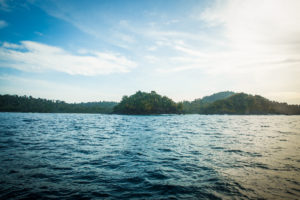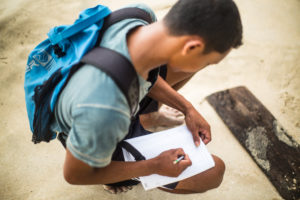| Applicant | Ecosystem Impact |
| Project coordinator | Luke Swainson |
| Location | Island off west coast of Sumatra, Indonesia |
| Pledged amount | €35.000 |
| Flagship species | White-rumped shama (Kittacincla malabarica) – LC and Nias Hill Myna (Gracula robusta) – CR |
Project funding progress
The Treasure island is an uninhabited island with large primary forest and extremely difficult access that makes it one of the last remaining bird paradise in Indonesia. It is haven for many birds targeted for illegal trade such as White-rumped shama which is the most traded species for songbird singing competitions. The Island is also home for the last remaining population of Critically Endangered Nias Hill Myna and its survival depends on island sufficient protection. The real name and exact location of the Treasure Island will not be disclosed for security reasons.
A local conservation NGO is the primary organisation focused on the island’s protection, and has a legal permit from the relevant government authority (BKSDA) to manage conservation efforts in the area. In cooperation with other NGOs (Ecosystem Impact & Lestari), this island has been identified as one of the last strongholds for the Nias Hill Myna, and the protection of the bird and its habitat there is a firm project commitment.
So far, songbird protection on the island is carried out by rangers as sideline while they are monitoring sea-turtle nest-sites. The funds will ensure the strengthening of monitoring and protection of threatened birds alongside the existing sea-turtle protection project. The outcomes of this project are to protect the White-rumped shama, Nias Hill Myna and all other species on the island from poachers and developers.
Project objectives:
- Increase the rangers’ presence on the island and add regular costal and terrestrial patrolling
- Adapt new strategies to concentrate more on bird poaching whilst still improving the protection of the sea-turtles. This initiative will directly benefit songbird population on the island and will have flow-on benefits for every species in residence.
- Monitor the White-rumped shama and Nias Hill Myna populations to assess species abundance, diversity and changes over time. Binoculars, camera traps, GPS & a satellite phone are required to ensure safety and accurate monitoring.
- Influence community opinions on bird poaching by ensuring their active engagement in the ranger team and education programs.
- Generate direct economic benefits through ecotourism and volunteering.
- Continue in policy and advocacy work at all levels of government to ensure that the island’s protection status is strengthened.
PROJECT UPDATE:
April 2020: EAZA Report_Q1 2020_Bangkaru
May 2020: Bangkaru Drone Shot Update
October 2020: EcosystemImpact_EAZA_Treasure_Island_Update_October2020


